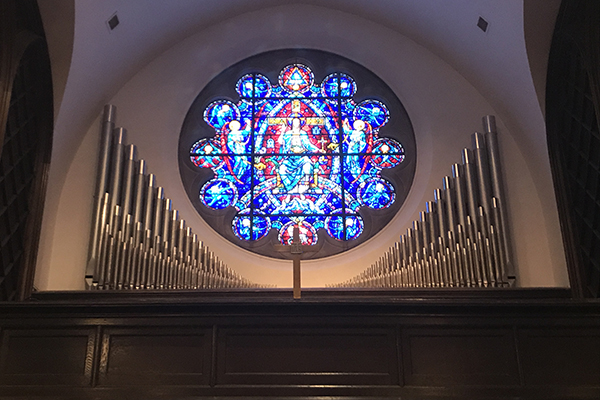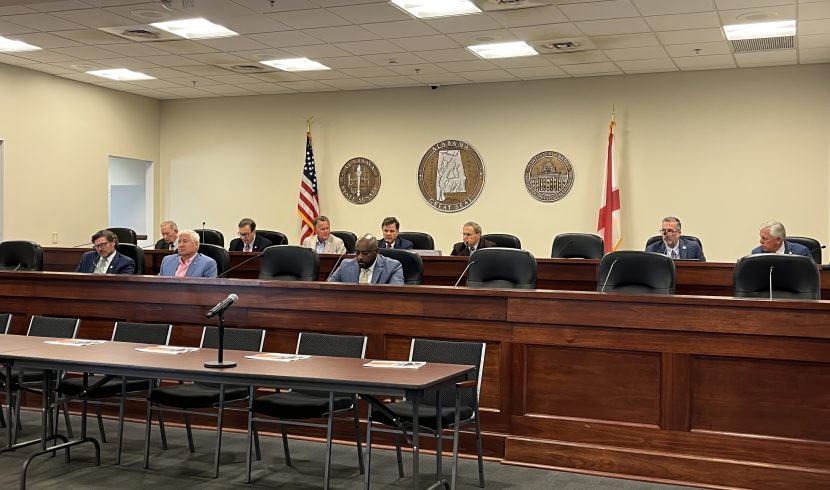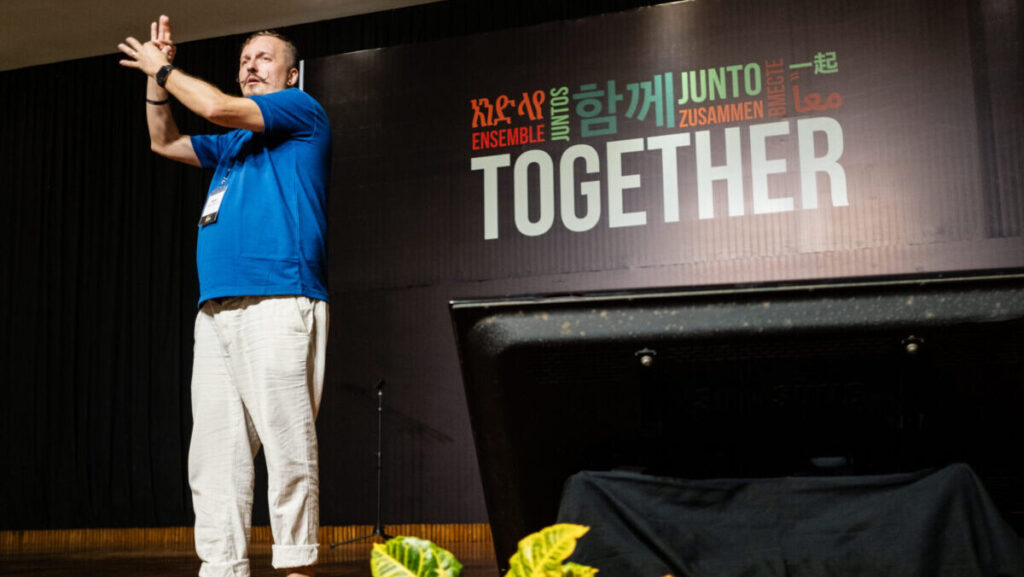Is the organ a viable instrument in today’s worship?
Organ not just for traditional music, minister says
By Karen Allen
Correspondent, The Alabama Baptist
Rejoice at the sound of the organ” (Job 21:12).
Forty years ago, that’s exactly what many churches did because the organ was their principal instrument for worship.
The organ-piano-choir trio was the typical Sunday morning music stage of the 1980s, but by the 1990s worship took on a different look as it began to “praise him with stringed instruments and organs” (Ps. 150:4).
What happened to the grandeur?
Can the King of Glory still use the king of instruments, or will the organ be turned “into the voice of them that weep” (Job 30:31)?
The answers depend on your viewpoint.
“The organ in today’s services are not the principal instrument as in the past and tend to be classical in nature,” said Keith Hibbs, director of the office of worship leadership and church music for the Alabama Baptist State Board of Missions.
He said that while there is no specific supporting data, the use of organs nationwide has declined drastically.
Churches call him hoping to rehome their organs, but he can offer no resolution.
Electric organs
“The decline started approximately 25 years ago and will be more notable in the next couple of years as electronic organs with MIDI (Musical Instrument Digital Interface) will need service and replacement,” he said.
MIDI allows computers, musical instruments and other hardware to communicate with one another to produce a variety of sounds, such as the sound of a harp, xylophone, falling rain or crashing thunder.
Hibbs said service for these instruments will be hard to come by and could be cost-prohibitive.
“The organ of today is a delicate hybrid of machinery and artwork,” noted Dennis Milnar, founder of Milnar Organ Company in Eagleville, Tennessee. Proper care for these instruments is crucial. His company has installed, restored and serviced numerous organs across the state and beyond.
An electronic organ does not require tuning, but a pipe organ needs tuning or service once or twice a year. The average cost runs $500 per tuning depending on the size of the organ, which is determined by the number of ranks or rows of pipes producing the same kind of sound for each note. A typical organ has 61 keys so a single rank will have 61 pipes of graduating lengths. Thus, a 60-rank organ is fairly large while an 18-rank organ is small.
The pipe organ at First Baptist Church, Birmingham, recently underwent $25,000 worth of repair.
Joseph Hopkins, minister of music at First, Birmingham, and also dean of Samford University’s School of the Arts in Birmingham, considers the organ to be “less expensive and more enduring than electronics.” Initially, the church was told it would cost $250,000 to repair the organ so it was pushed against the wall. Hopkins determined the organ could be repaired over time for considerably less and re-introduced it into worship services.
“It’s really just about being willing to allow the organ as one of the instruments in our worship,” he said.
When asked if the organ should be limited to specific worship styles, Hopkins suggested it could be used in many contemporary applications. David Vaughan, worship pastor at Meadow Brook Baptist Church, Birmingham, agreed.
“That’s the beauty of music and the colors we have,” he said. The organ at Meadow Brook Baptist aids in congregational singing every Sunday. “The organ has been the most common and even assuring voice in worship,” he said.
Like Hopkins, Vaughan does not believe in limiting the organ to specific music styles and hopes to use it more freely in the future. He senses a slow resurgence of hymnody in churches across the nation, especially in liturgical settings.
Hopkins believes the younger generation is turning back to traditional worship forms and because of this trend, he does not foresee a decline in organ use.
Worship at Shades Mountain Baptist Church, Vestavia Hills, tends to be more modern.
“Our desire is to keep the melodies and lyric content of classic hymns and worship music while bringing modern instruments and style to that content,” said Michael Adler, Shades Mountain worship pastor.
He identified two things that have coincided in the worship community at Shades Mountain: the cost of maintaining the organ through temperature and humidity fluctuations and a shift in musical content and style.
Service costs
Adler noted that at one point an organ technician had to be flown in from Canada twice a year. Even after finding one in the United States, he said the service cost was as high as the cost of purchasing a maintenance-free electronic keyboard. He now reserves the organ for big events.
Russell Williams, pianist and organist at First United Methodist Church, Trussville, has observed hybrid services which combine traditional and contemporary worship styles, using the pipe organ in a support function but not as the principal instrument.
“In a decade or less, only the larger, wealthy and conservative churches which still use a traditional service format will use the pipe organ,” Williams predicted.
Membership in the Birmingham Chapter of the American Guild of Organists (AGO) lends support to Williams’ prophetic statement.
“Of the 40 or so churches — medium to large-sized — represented in the Birmingham AGO, the majority follow a traditional service format,” said Dan Lawhon, dean of the Birmingham AGO.
Megachurches tend to follow contemporary formats.
From a marketing perspective, Milnar has seen decreased sales over the past 20 years in his company for small to medium-sized organs but increased sales for large organs. He believes there is a strong movement in the country to restore and preserve our American organ history.
_______________________________________________________________________
Where have all the organists gone?
Gap to replace organists is widening; younger generation favors guitars
By Karen Allen
Correspondent, The Alabama Baptist
Has playing the organ become a dying art like shorthand and tatting? What has happened to the organists — the ones who read three staffs of music, dance on the pedals, maneuver multiple manuals, pull organ stops, push pistons, manipulate swell and crescendo pedals and follow a director — all at the same time? Is there no one else to sit on the bench where “Aunt Sally” sat for 40 years?
Eric Mathis, director of The Center for Worship and the Arts at Samford University in Birmingham, said, “There is a national trend for fewer students who major in music with an organ emphasis.”
Samford has had only one incoming freshman majoring in organ each of the past two years. Some piano majors are choosing to complement their degrees with organ in order to diversify their abilities and experiences.
“All musicians, not just organists, must possess broad skills to have a viable career in music,” Mathis said.
Even Jubal, the biblical father of music, diversified by playing more than one instrument: “And his brother’s name was Jubal: he was the father of all such as handle the harp and organ” (Gen. 4:21).
Educational requirements are demanding for organ majors. Samford offers an organ performance degree as well as a degree in music and worship or music education with an emphasis in organ. Other Alabama universities, including the University of Alabama, Birmingham Southern and the University of Montevallo, offer similar degrees.
But not all organists have degrees in music. Approximately half of the Birmingham American Guild of Organists (AGO) chapter members, including supporters, do not have music degrees.
Organ programs
Schools with nationally reputable organ programs such as Baylor University in Waco, Texas, and Mercer University in Macon, Georgia, have seen increases in the number of organ majors. Other, lesser-known university organ music programs have dropped their programs altogether. Dan Lawhon, dean of the Birmingham AGO, admitted we could be “shooting ourselves in the foot” by not having universities give priority to keeping up a high organ profile.
With fewer trained students, the gap to replace organists is widening. Rural churches have even wider gaps. “Aunt Sally,” who is retiring at 70, 80 and even 90 years of age after decades of service, has no one to replace her from the younger generations.
Most organists in the Birmingham AGO are over 40 years old, said Lawhon, noting he has detected more difficulty in filling organist vacancies in the past 10 years.
Keith Hibbs, director of the office of worship leadership and church music for the Alabama Baptist State Board of Missions, has experienced the consequences. It has been seven years since the organ in his home church, Dalraida Baptist Church, Montgomery, has been played. Church leaders finally gave up after trying to find an organist and removed the organ when the church was renovated.
Hibbs offered two words for those attempting to fill an organist vacancy: “Good luck!”
To accommodate for organ vacancies, some pianists switch to organ but a pianist is not the same as an organist. The music may be the same but the skills, sounds and techniques are not. For example, the common practice of sustaining is achieved by an organist’s fingers and feet while the piano has a sustain pedal that is pressed.
Lawhon noted that “keyboard studies overall are not as prevalent as in the past.”
This is corroborated by Hibbs who agreed there has been an ongoing pianist shortage for 25 years. Why? One reason is the level of commitment. Another is the cost for years of lessons, in addition to tuition and private lessons for those seeking degrees. Then there is the cost for the instrument itself as well as its maintenance.
Generational instrument
The guitar has become the instrument of this generation. It’s easier to play, faster to learn, requires less commitment and is significantly less expensive to purchase and maintain.
Mathis noted, “The guitar’s portability has increased the variety of worship practices such as worship around a campfire or in home groups.”
Another strong advantage of the guitar is that it is considerably easier to find a replacement guitarist.
Opportunities for organists are diminishing in direct proportion to the prevalence of the traditional service, said Russell Williams, pianist and organist at First United Methodist Church, Trussville.
“Congregations have to get creative to hire organists,” Mathis said, “and organists have to be flexible and open to more responsibilities.”
Organist positions are typically part-time positions with a wide salary range depending on church size and expectations as well as the organist’s experience and education. Many churches are choosing to combine the organist position with another role. It is rare to find a full-time organist position at any church of any denomination.
And not every organist is a good fit for every church. Churches have different needs so they must find the right fit in their organist to meet those needs.
What is the response to this widening gap of organist vacancies?
The AGO encourages mentoring of students within the church and community. Every year the AGO hosts a Pipe Organ Encounter Advanced Workshop for auditioning high school students across the U.S. The AGO routinely hosts other nonauditioned events to instill greater organ interest.
Samford also is taking strides to promote more interest in the organ and recently made one of its five-year goals to “increase appreciation of the role of the organ in worship — whether as the primary instrument or as an instrument in the band.”
Samford also added a new scholarship fund provided from a donor specifically for organ students who have significant interest in the role of the organ in congregational song.
Summarizing the organ and organist dilemma, Mathis said, “People assume that because there are fewer organists and churches with organs in worship that the organ is dying. The organ is not dying, nor are the organists.”
State of change
“Church music is in a constant state of change, and with the addition of praise and worship, the worship life of the congregation has changed. … Many churches have built new sanctuaries, installed multimillion dollar organs and hired organists, while other congregations across our state have built multipurpose buildings that don’t have organs because they cannot attract and/or afford organists. Both have followed their callings from God,” Mathis said.
“The important thing is that the Word of God continues to be heard in worship and that each congregation has found its calling and its voice musically.”






Share with others: